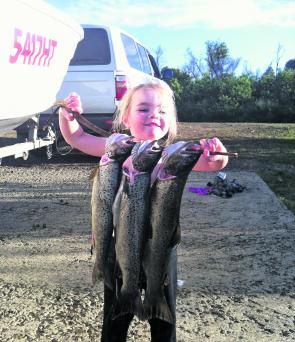Things are really starting to cook now in the Southern Highlands.
In recent weeks at Bronte Lagoon, last season’s gum beetles, stoneflies and crane flies have been getting the trout up on top and the adult damsels have made an appearance with the trout starting to track them and grab them out of the air in their usual spectacular fashion.
The trollers and spinner anglers have also had fun with good fish being landed all over.
Lake Meadowbank, Cluny Lagoon, Lake Repulse, Lake Catugunya and Wayatinah Lagoon all provide good fishing in the first month of the New Year. There should still be plenty of Atlantic salmon swimming around in Meadowbank from the previous releases of salmon averaging 2.5kg. Usually in January at Meadowbanks on a calm morning the fish are rising well to caenids: the fly life is there I’m just not convinced that the trout stocks are up to scratch.
Cluny, Repulse, Catagunya and Wayatinah are all good destinations for all forms of fishing and they all offer surprisingly good flyfishing, featuring good rises to terrestrials and aquatic life. Cluny and Wayatinah have good shore fishing but Repulse and Catagunya are by far, better fished by boat due to limited shore access.
Bronte is simply awesome in January, particular so for the fly fisher. The trout are looking up and everything is rosy! You can expect to find good rises to mayfly duns and spinners, although the spinner feeders are more reliable, it seems these days. The midging fish in the early mornings are also very reliable.
Don’t overlook Bronte on those blue sky days either. Bronte isn’t as well known for its polarizing as other waters are further up the hill but it has some very good polarizing shores and is always a damn sight less crowded during blue sky days over the holiday period. Tailers Bay, Monument Bay, all of the Road Shore and Rowallan Bay are among the best areas and indeed the polarizing over the beautiful Rowallan Bay grassy bottom for trout tracking damselflies and spinners can be exhilarating.
If you aren’t worn out by evening, the caddis hatch can really turn it on at times.
Difficult but at the same time very rewarding is Dee Lagoon. Expect to find good numbers of browns and rainbows feeding both on chironomids in the windlanes and caenid both in the windlanes and closer in around the shores, from day break through to around 9:30 or 10am or so. For most of the lagoon a boat is very necessary. Blue sky days are also very special at the Dee. Creep along with your electric motor close to the shore and keep a sharp look out and be prepared to cast fast and accurate, the Dee fish love to cruise hard in on the shore, under the overhanging bushes and trees and around the many underwater logs, looking terrestrials.
Great wade polarizing to fish feeding on Black Spinners here. You can wade most of the lagoon in the summer months just be careful of the soft holes around the north east section of the lagoon.
There is excellent fishing in some amazing surrounding scenery. Expect some great rises to beetles, chironomids and mayfly, but don’t forget sub-surface flies either. Recently fish have been taking stick caddis imitations very well. Trollers and lure casters should still land big bags of small but eager fish; King William really has fished well this season.
If you’ve never been to Burbury, January is the month to start visiting, the weather is a lot more settled but please pay attention to the weather map and look for a high directly over the West Coast of Tassie. Lake Burbury can be the best place to be in fine weather and the worst place to be in the rough weather. The windlane fishing here is the stuff they write songs about, it is that good, great windlanes full of food a real soup kitchen for the very fit Burbury rainbows and to a lesser extent browns.
It isn’t easy fishing though, you’ve got to be able to cast reasonably long and on target and have a good eye for detecting midging fish and the direction they are feeding in. Floating mudeye patterns such as the fantastic Cubit Mudeye or other deer hair patterns are great in low light, wet mudeyes also work well slowly stripped in front of a feeding fish. We’ve also had a lot of success on long green nymph patterns. The usual dries such as a small Iron Blue Dun or Klinkhammer style flies will also go well if your cast is accurate.
Even for the beginner fly fisher though, there is a trick to Burbury. Even if you can’t cast quick enough or accurate enough to land the fly in front of the fish feeding on the surface, find a good wind lane with plenty of food in it and sink a wet mudeye pattern or a largish green nymph down on the edge of the wind lane and slowly retrieve it back and expect a take at any minute! What you see on the surface of the wind lane is only part of the story, underneath the surface there is also a plethora of trout food and the fish patrol underneath the surface as well as they feed on top, I’ve had good fish almost rip the rod out of my hand when sinking a wet down and retrieving it slowly back to the boat.
Reads: 3481
Nathan Huizing with a beautiful Bronte Lagoon brown trout.

Two and a half year old Bronte is as proud as punch with these great browns taken trolling at Lake Repulse.




